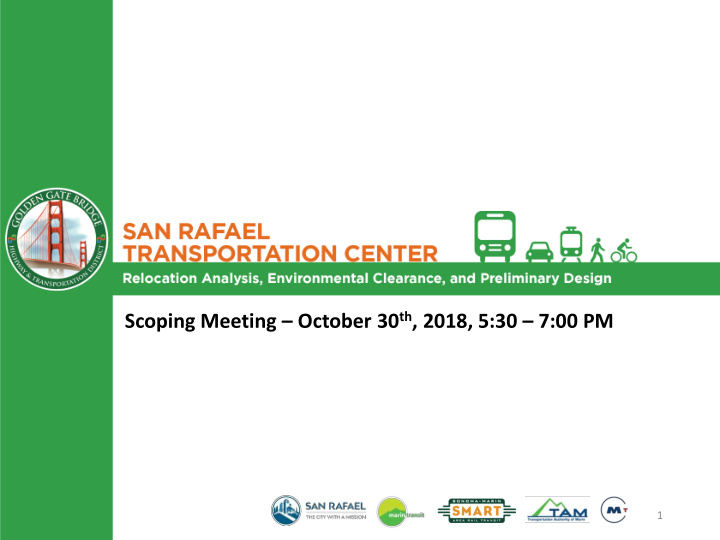



Scoping Meeting – October 30 th , 2018, 5:30 – 7:00 PM 1
Scoping Meeting Purpose • Requirement for CEQA • Review of Notice of Preparation • Receive written public comments on alternatives to be considered and scope of environmental analysis 2
Open House Format • Background Information • Project Information • Environmental Process, Purpose & Need • Transit Center Concepts • Provide Scoping Comments 3
Project Process We are here 4
Project Schedule 5
Community Outreach Process • Community stakeholders initially raised concerns regarding project development and concept selection processes; the project team worked collaboratively to implement an open and transparent process • Five phases of public engagement Listening (March 20 th Open House & March Survey) 1. 2. Input on Specific Concepts (June 12th Open House, Canal Outreach, June/July Survey) 3. Scoping for Environmental Analysis (October 30th Meeting) 4. Selection of Alternatives (Spring 2019) 5. Share Findings of Environmental Analysis (2019) 1 2 3 4 5 6
Community Engagement – First Round • Goals: Introduce project, reset community perceptions of process • Open House held March 20 th , 2018 • Approximately 75 attendees • Online survey open March 20 th through May 1 st • 206 responses received Community Engagement – Second Round • Goals: Share proposed concepts and receive feedback • Open House held June 12 th , 2018 – approximately 60 attendees • Online survey open June 12 th through July 15 th – 187 responses • Two pop-up events in the Canal Neighborhood • Letters received from community groups 7
Study Area 8
Design Requirements - Facilities • Must accommodate transit operations • 17 bus bays, matching current transit center • Customer waiting areas • Customer service in close proximity • Operator facilities • Wayfinding and transit information • Bike parking • Pick-Up/Drop-Off curb space for taxis and TNCs • Security and lighting 9
Concept Development Process • Identify sites that are capable of meeting the program and meet the transfer needs of patrons • Assess bus routing and circulation that allows for bus access/exit • Delineate space for pedestrian and bicycle circulation internally and externally • Identify opportunities for supportive uses, urban design, and placemaking components 10
Alternatives Evaluation Process • Alternatives evaluated against project purpose and need • Assessment of environmental impacts • Technical analysis based on CEQA requirements • Stakeholder agency input • Community input
Provide Scoping Input • Potential environmental issues to be analyzed in the environmental document • Feedback on alternatives currently identified • Other alternatives that should be considered • Provide written feedback on comment forms or via e-mail (SRTC@goldengate.org) 12
What Happens Next • Project team review of scoping comments • Preparation of environmental technical studies • Evaluation of alternatives • Public Meetings • Selection of a Preferred Alternative 13
Project Contact Information • E-mail: SRTC@goldengate.org • Phone: (415) 257-4444 (dedicated project line) • View our website at: goldengate.org/SRTC 14
Recommend
More recommend